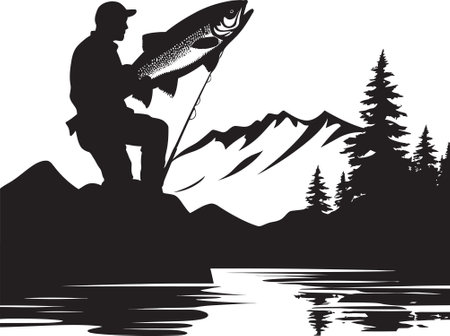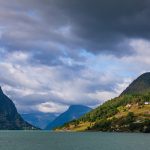1. Introduction to River and Stream Fish Habitats
Rivers and streams across the United States are home to a wide variety of fish species, each with unique habitat preferences. From cold, fast-moving mountain creeks to warm, meandering lowland rivers, these freshwater systems support both native and introduced fish populations that are important for biodiversity, ecological balance, and recreational fishing.
The Role of Rivers and Streams in U.S. Ecosystems
Rivers and streams are more than just flowing water—they connect landscapes, transport nutrients, and provide essential habitats for fish at different stages of their life cycles. These waterways also influence the health of nearby wetlands, forests, and even human communities. Understanding how fish interact with their riverine environments helps us manage these ecosystems more effectively.
Why Understanding Fish Habitat Preferences Matters
Knowing where fish prefer to live within rivers and streams allows biologists, conservationists, and anglers to make better decisions. Whether its protecting endangered species or improving fishing opportunities, understanding habitat preferences can help us:
- Restore degraded habitats more effectively
- Manage fish populations sustainably
- Improve water quality through targeted conservation efforts
- Enhance recreational fishing experiences
Types of River and Stream Habitats
Fish don’t just live anywhere in a river—they seek out specific features based on their needs for food, shelter, and reproduction. Here’s a quick look at some common habitat types found in U.S. rivers and streams:
| Habitat Type | Description | Common Fish Species |
|---|---|---|
| Riffles | Shallow areas with fast-moving water over rocks or gravel | Trout, Smallmouth Bass, Dace |
| Pools | Deeper sections with slower current; often used as resting spots | Largemouth Bass, Catfish, Sunfish |
| Runs | Smooth-flowing stretches between riffles and pools | Salmon, Steelhead, Walleye |
| Undercut Banks | Eroded stream banks offering shelter from predators and current | Bass, Pike, Crappie |
A Foundation for Conservation and Recreation
By identifying where different species thrive within river systems, we can better protect those environments while also promoting responsible outdoor recreation. For anglers across the U.S., this knowledge translates into smarter fishing strategies—like knowing when to cast near a riffle or when to explore deeper pools during warmer months.
2. Key Physical and Environmental Factors
Understanding where fish like to live in rivers and streams means looking closely at the physical and environmental conditions of the water. These factors play a big role in where different species choose to hang out, feed, or spawn. Let’s break down some of the most important elements that influence fish behavior and distribution.
Water Temperature
Different fish species have preferred temperature ranges. For example, trout thrive in cooler waters, while bass are more comfortable in warmer temperatures. If the water gets too hot or too cold outside their comfort zone, fish may move elsewhere or become less active.
| Fish Species | Preferred Temperature Range (°F) |
|---|---|
| Brook Trout | 52–61°F |
| Largemouth Bass | 68–78°F |
| Smallmouth Bass | 65–75°F |
| Rainbow Trout | 55–65°F |
Flow Rate
The speed and movement of water affect how fish position themselves. Some species prefer fast-moving water with plenty of oxygen, like riffles, while others stick to slower pools where they can conserve energy. Fish will often face upstream to catch food drifting by.
Substrate Type
The riverbed material—like gravel, sand, rocks, or mud—can make a big difference for fish. Gravel beds are ideal for spawning for many species like salmon and trout. Muddy bottoms may support more insect life but might not be suitable for egg-laying.
| Substrate Type | Common Fish Associations |
|---|---|
| Gravel | Trout, Salmon (spawning) |
| Sand | Catfish, Carp |
| Mud/Silt | Bullhead Catfish, Carp |
| Cobble/Rocky | Smallmouth Bass, Darters |
Aquatic Vegetation
Plants growing in or near the water provide shelter, shade, and food sources for many fish. Vegetation also helps young fish hide from predators. Insect-eating fish often stay near weeds where bugs are plentiful.
Dissolved Oxygen Levels
Fish need oxygen just like people do—but they get it from the water. Fast-moving streams usually have higher oxygen levels than stagnant pools. Warmer water holds less oxygen, so it’s common to see fewer fish in slow, warm areas during summer months.
Oxygen Needs by Fish Type:
| Fish Species | Minimum Dissolved Oxygen (mg/L) |
|---|---|
| Trout | >6.0 mg/L |
| Bass | >5.0 mg/L |
| Carp | >3.0 mg/L |
By keeping these key factors in mind—temperature, flow rate, substrate type, vegetation, and oxygen levels—you’ll have a better idea of where to find different kinds of fish in river and stream systems.
![]()
3. Common Fish Species and Their Habitat Preferences
Understanding the habitat preferences of popular freshwater gamefish in rivers and streams can help anglers target the right locations more effectively. In this section, we’ll take a closer look at some of the most commonly pursued species in U.S. waters: bass, trout, and catfish. Each of these species has unique environmental needs and behavior patterns that determine where they are likely to be found.
Bass
Largemouth Bass prefer slower-moving waters with plenty of cover like submerged logs, weed beds, and undercut banks. They thrive in warm water temperatures between 65°F and 85°F. Largemouths are ambush predators, so they often stay near structures where they can hide and strike prey.
Smallmouth Bass, on the other hand, favor clearer, cooler, and faster-flowing sections of rivers and streams. They are commonly found near rocky areas, gravel beds, or riffles where oxygen levels are higher.
Bass Habitat Preferences Summary
| Species | Preferred Water Temp | Water Flow | Common Structures |
|---|---|---|---|
| Largemouth Bass | 65–85°F | Slow-moving | Weeds, logs, undercuts |
| Smallmouth Bass | 60–75°F | Moderate to fast | Rocks, gravel beds, riffles |
Trout
Trout are typically found in coldwater stream environments with high oxygen levels. Rainbow Trout, Brown Trout, and Brook Trout all prefer clean, well-oxygenated water, often between 50°F and 65°F. These fish tend to hold in deeper pools during warmer months but can also be spotted near riffles and runs where food is carried by the current.
Trout Habitat Preferences Summary
| Species | Preferred Water Temp | Water Flow | Common Areas Found |
|---|---|---|---|
| Rainbow Trout | 50–65°F | Moderate to fast | Pools, riffles, runs |
| Brown Trout | 52–68°F | Moderate flow with cover | Boulder pockets, deep holes, undercut banks |
| Brook Trout | 45–60°F | Crisp flow in small streams | Sheltered pools, overhangs, woody debris |
Catfish
The three most common types of catfish found in U.S. rivers and streams are Channel Catfish, Blue Catfish, and Flathead Catfish. These bottom-dwelling fish prefer slower-moving currents with soft substrates like mud or sand. They’re usually active during dusk or night hours and seek out deep holes or areas near submerged logs or brush piles for shelter.
Catfish Habitat Preferences Summary
| Species | Preferred Water Temp | Main Habitat Features |
|---|---|---|
| Channel Catfish | 70–80°F | Muddy bottoms, deep pools, log jams |
| Blue Catfish | 70–85°F | Main channels with strong current and depth variation |
| Flathead Catfish | 75–85°F | Sheltered holes near structure like rocks or trees underwater |
The Importance of Reading the Water Right for Each Species
No matter which fish you’re targeting in a river or stream system, matching your fishing location to their preferred habitat can make all the difference. Pay attention to water temperature, flow rate, available cover, and depth changes—these environmental cues are key indicators of where fish might be holding. By learning how to read these signs on the water, youll greatly improve your chances of success on your next fishing trip.
4. Human Impact and Habitat Changes
When it comes to fishing rivers and streams, understanding how human activity affects fish habitats can make a big difference in your success. Over time, agriculture, urban development, dam construction, and pollution have all changed the natural flow and structure of waterways. These changes can alter where fish live, feed, and spawn. As anglers, being able to spot these changes helps us find where the fish are likely to be.
Agriculture
Farming near rivers often leads to runoff that carries fertilizers, pesticides, and sediment into the water. This can reduce water clarity and lower oxygen levels, which some fish species don’t tolerate well. Fish like trout that prefer clean, cold, oxygen-rich water may move upstream or to spring-fed areas when downstream sections become too warm or murky.
What Anglers Can Look For:
- Muddy or cloudy water after rain—likely runoff from nearby fields
- Algae blooms—can signal excess nutrients from fertilizer
- Reduced insect life—fewer bugs often means fewer feeding fish
Urban Development
Cities near rivers often mean more pavement and less natural shoreline. Rainwater runs off streets and rooftops quickly, leading to flashier flows that erode banks and disturb habitat. Urban streams may lose natural cover like overhanging trees or submerged logs that fish use for shelter.
What Anglers Can Look For:
- Straightened or channelized streams—less natural structure for fish
- Lack of shade—warmer water temperatures can push cool-water species away
- Concrete banks or culverts—may disrupt spawning grounds
Dam Construction
Dams block fish migration routes and change the flow of rivers. Water released from dams is often colder than natural downstream temperatures, which can benefit some species but harm others. Reservoirs above dams may create new fishing opportunities but also flood traditional habitats.
What Anglers Can Look For:
| Above Dam (Reservoir) | Below Dam (Tailwater) |
|---|---|
| Slower currents | Colder water temps year-round |
| Deeper water with suspended fish | Consistent flows ideal for trout |
| Flooded timber or creek channels as structure | Rocky areas below spillways attract baitfish & predators |
Pollution
Chemical spills, sewage discharge, and trash all impact water quality. Fish may leave polluted areas entirely or become stressed and harder to catch. Some species are more tolerant than others; catfish might stick around longer than trout in poor conditions.
What Anglers Can Look For:
- Strong odors or visible oil sheen on water surface—signs of contamination
- Lack of aquatic vegetation—polluted waters often cant support healthy plant growth
- Dead fish or low diversity of species—bad sign for overall habitat health
Quick Tips for Spotting Altered Habitats:
| Sign | Possible Cause | Fish Behavior |
|---|---|---|
| Muddy water after storms | Agricultural runoff | Fish may move upstream to clearer water |
| Straightened stream with no cover | Urban development | Fish hide near bridges or debris piles instead |
| Cold tailwater below dam in summer | Dam release | Trouble zone for trout fishing during hot months |
| No insects under rocks or along banks | Pollution or sediment overload | Poor feeding ground for most species |
The next time youre on the riverbank wondering why your usual spots aren’t producing bites, take a moment to look around. Human impacts might have changed the game—but if you know what signs to look for, you’ll stay one step ahead.
5. Field Methods and Tools for Identifying Habitats
When it comes to finding the best fishing spots in rivers and streams, understanding where fish like to hang out is key. This means getting hands-on with some practical tools and techniques that help you pinpoint fish-friendly areas. Whether youre a weekend angler or a dedicated river explorer, using the right gear can make all the difference.
Using Maps for Planning
Topographic and hydrographic maps are great starting points for identifying potential fish habitats. These maps can show you water flow, depth changes, pools, riffles, and even man-made structures like dams or bridges where fish might gather. Many anglers use online mapping tools or GPS-enabled apps to scout locations before heading out.
Recommended Map Types
| Map Type | What It Shows | Why It’s Useful |
|---|---|---|
| Topographic Map | Elevation, terrain, river bends | Helps locate deep pools and shallow runs |
| Hydrographic Map | Water depths and flow patterns | Useful for spotting drop-offs and channels |
| Satellite Imagery (Google Earth) | Visual layout of water systems | Great for scouting access points and vegetation cover |
Sonar Devices & Fish Finders
Portable sonar units or castable fish finders can give you a real-time look under the surface. These devices use sound waves to detect structure, depth, and even schools of fish. Some models connect to your smartphone so you can see underwater features directly on your screen.
Popular Sonar Features
- Depth Readings: Know how deep the water is at your location.
- Bottom Contours: Spot ledges, holes, and drop-offs where fish may hide.
- Fish Icons: Some models identify fish size and position.
Temperature Gauges & Thermometers
Water temperature plays a big role in fish behavior. Different species prefer different ranges—like trout that thrive in cooler waters or bass that get more active in warmer temps. Carrying a simple stream thermometer can help you find sections of the river that match your target species’ preferences.
General Temperature Preferences by Species (°F)
| Species | Preferred Temp Range |
|---|---|
| Bass (Largemouth) | 65–80°F |
| Trout (Rainbow/Brown) | 50–65°F |
| Panfish (Bluegill/Sunfish) | 60–75°F |
Observational Techniques
Your own eyes can be one of the most powerful tools when identifying fish habitats. Watching the flow of water, spotting eddies behind rocks, and noticing insect activity on the surface can all give clues about where fish are feeding or resting.
Telltale Signs of Good Fish Habitat:
- Eddies: Calm spots behind rocks where fish conserve energy.
- Undercut Banks: Shaded areas that provide cover from predators.
- Bubbles or Foam Lines: Indicate current seams where food collects.
- Splashing or Rising Fish: A sure sign that fish are active on the surface.
The more time you spend observing and using these field methods, the better you’ll get at reading the water like a pro. With practice—and the right tools—youll start recognizing prime fishing spots faster and with more confidence.
6. Applying Habitat Knowledge to Improve Fishing Success
Understanding where fish like to hang out in rivers and streams is a game-changer for anglers. When you know the type of habitat a fish prefers, you can plan your fishing trips more effectively—choosing the right spot, time, and technique. Heres how you can use habitat data to your advantage.
Reading the Water: What to Look For
Different fish species have different needs, and they tend to gather in areas that meet those needs. Here are some common river and stream features to watch for:
| Habitat Feature | Fish Species Likely Found | Why They Like It |
|---|---|---|
| Deep Pools | Bass, Trout, Catfish | Cooler water, protection from current |
| Eddies (swirling water behind rocks) | Trout, Smallmouth Bass | Slower water with easy access to food |
| Undercut Banks | Bass, Sunfish | Shelter from predators and strong current |
| Gravel Beds | Trout, Salmon (spawning season) | Ideal for laying eggs during spawning |
| Overhanging Vegetation | Panfish, Trout | Shade and insects dropping into water |
Choosing the Right Time of Day
The time of day matters just as much as location. Fish behavior changes depending on light levels, temperature, and feeding habits.
Best Times to Fish Based on Habitat Type:
- Morning: Shallow runs and riffles—fish are active and feeding.
- Midday: Deep pools or shaded banks—fish move to cooler spots.
- Evening: Edges of pools or near vegetation—fish come out to feed again.
Selecting Tactics That Match Habitat Conditions
Your choice of bait or lure should reflect the environment youre fishing in. Heres a quick guide:
| Habitat Type | Tactic / Gear Recommendation |
|---|---|
| Fast-moving riffles | Sinking lures, nymph flies; keep bait low in the water column |
| Deep pools | Weighted rigs, soft plastics; focus on slow presentation near bottom |
| Eddies and seams (where currents meet) | Casting upstream with natural drift; spinnerbaits work well here too |
Putting It All Together: Smart Fishing Strategy
The key is observation and adaptation. Watch how the water moves, note the surroundings, and think about what a fish would want—a calm spot with food nearby and cover from predators. Use maps or apps that show streamflow data or temperature readings if available. And always be ready to switch things up if youre not getting bites. The more you understand fish habitat preferences, the better your chances of landing that next big catch.


